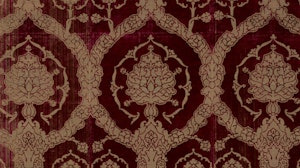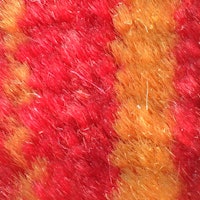Renaissance Velvet Workshop Practices
Published by Reblogs - Credits in Posts,


Red-Handed: Exposing Renaissance Velvet Workshop Practices
From the Conservation Studio
Share
Anna Dumont, Isaac Facio, Ken Sutherland, and Giovanni Verri
January 23, 2024
During preparation of a large velvet altar frontal for display in the galleries of medieval and Renaissance art, our team of conservators, conservation scientists, and curators noticed something strange.
Running along the vertical axis of the deep red velvet and gold fabric of the frontal were mysterious yellow stripes. The lines had crisp edges but were irregularly spaced, sometimes broad, sometimes as thin as one fine silk thread.
Spain or Italy. Kate S. Buckingham Endowment
The stripes were continuous along the entire length in some areas, but more fragmented in others. They were clearly not an intentional part of the pattern of pomegranates and foliage, and appeared nothing like the familiar kinds of damage—caused by light exposure, water, folding, or insects—that very old textiles often sustain. Instead, we realized that we were looking at a glitch in the making of the textile itself, a rare error in the weave that, if we could understand it, could reveal secrets of Renaissance workshop practices.
Spain or Italy. Kate S. Buckingham Endowment
One problem was that we had only the vaguest idea of when and where the object was made. Based on similarities in materials and patterning, it was attributed to Spain or Italy from the late 15th to the 16th centuries. Its life before it was purchased by the museum in 1944 was a blank. The answers, if we could find them, would have to come from a close examination of the textile itself, clues that could then be matched against crumbs of historical evidence from dusty archives.
Our altar frontal has all the qualities of a splendid fabric. Rich and vibrantly colored, it is composed of four lengths seamed together. The intricate design produces a plush velvet with two different pile heights (the sumptuous carpet of fuzzy fibers that gives velvet its classic texture) and areas of metal thread brocade. The metal threads are made with finely cut strips of metallic silver finished with a thin gold leaf on the outer surface, a method of production that gives the appearance of gold while reducing the cost, and consistent with similar threads found in other examples of European Renaissance textiles.

Detail showing the unique character of red velvet with two heights of pile, contrasting with gilded metal threads.
From the second panel from the left (with no yellow striping)

Detail of metal brocade
Note how the gold-plated silver is wrapped around the silk threads.
The heart of the mystery of the yellow stripes lay in the mismatch between the effort and expense required to make this velvet in this period and a flaw that would have destroyed its value in the competitive global market for luxury textiles. The weaving of silk velvet was the most complicated and expensive form of textile production in the Renaissance. It was slow—a master weaver could perhaps complete a few inches a day—and the raw materials of silk and dyestuffs, often sourced continents away, were unimaginably costly. Why would a weaver have poured their time and money into making something that could have been almost worthless?
Renaissance velvets were woven from threads that had already been dyed. The yarns were prepared by a separate guild, the tintori, who were governed by their own set of highly specific rules. Here’s the frontispiece of a book of dyers’ guild regulations from 16th-century Valencia showing St. Michael measuring out dyestuffs.

First page of the Valencian Silk Dyers Ordinances (1506–78) with an image of St. Michael, patron of the brotherhood
Valencia, Archivo del Colegio Del Arte Mayor de la Seda, inv. no. 4.i.
The great scholar of the Venetian silk industry, Luca Molà, found an endless cat and mouse game between the Provveditori alla Seta—the Silk Inspectors Office—and dyers and weavers who attempted to pass off lower-quality dyestuffs as the more desirable and durable products. As we began to look closely together at the altar frontal, we came to suspect that the problem might be a question of dyes. If the red color of some of the silk threads came from one dye, and others were dyed with something with a different degree of lightfastness, that could account for the difference.
For investigation of the velvet dyes we were fortunate to collaborate with a colleague at the University of Amsterdam, Ana Serrano, who used a specialized technique called high-performance liquid chromatography to identify the colorants. The analysis required careful extraction of a small sample of fibers from a discreet location in the fabric for testing. It determined that the red silk fibers were colored using cochineal, a widely used, bright crimson dye derived from a type of parasitic insect, still in popular use today. In contrast, the now-yellow fibers were found to have been treated with a plant-based dye called brazilwood.
color discrepancy

Detail of velvet pile
Yellow stripes are clearly visible in the red fabric

Detail of the reverse side of the textile
Analysis revealed that the red fibers were dyed with cochineal.

Detail of knot on reverse side showing two distinct colors of yarn
The fibers appearing yellow were dyed with brazilwood, now discolored
Although brazilwood would have originally provided a deep red color equally beautiful to that of cochineal, it is more prone to fading, and if exposed to light for extended periods of time it loses its bright red color, revealing the yellow color of the fiber. The dye analysis helped us to understand the unusual appearance of the velvet. Originally a uniform red color, fading of the brazilwood dyed silk over the centuries generated these distinctive yellow stripes.
The finding also raised new questions. Why were the two types of dyed silk used together in this fabric? Was this the result of an innocent mix-up of materials? Was the brazilwood employed knowingly, as a cost-saving measure? Did the dyer hide this fact from the textile manufacturer—or did the dyer and textile manufacturer commit fraud together?
Fraud was a consistent problem in Renaissance textile production, raising the possibility that our velvet is the product of a criminal conspiracy. A trial from 1453, for example, found the dyer Francesco Leonardi guilty of conspiring with two weavers, or setaioli. They were accused of "fraudulently and mischievously" dying silk with only a small amount of the durable insect-based dye (in this case a related colorant known as kermes) and then washing the yarns in brazilwood to enhance the color. They attempted to pass it off as true scarlet paonazzo, the highest-quality category of red thread.

Plate from Trattato dell’arte della Seta, 1489
Unknown maker, Florence, Biblioteca Laurenziana. Are these Florentine dyers up to no good?
To the great consternation of the guild, the fix was only discovered once the bolts of fabric had been made into clothing in Venice and Padova and the noblemen watched as their flashy red garments quickly faded. Found guilty, the culprits were sentenced to pay fines and damages to their buyers.
The documentary record so far has revealed little record of mixed warp dyes like those we have discovered here. In this way, our altar frontal provides its own record of how Renaissance textiles were made. We hope that further study of this and similar textiles will help to shed light on technical—and possibly ethical— aspects of workshop practices in Renaissance Europe.
—Anna Dumont, 2022–23 COSI Mellon Fellow, Textiles; Isaac Facio, associate conservator, Textiles; Ken Sutherland, Andrew W. Mellon Director, Scientific Research; and Giovanni Verri, conservation scientist
Special thanks to Ana Serrano, assistant professor in Conservation and Restoration, University of Amsterdam
The altar frontal is currently on view in Gallery 237, along with other arts from Medieval and Renaissance Europe.
Citation
Germán Navarro Espinach, "Fifteenth-Century Spanish Velvet Production," in Velvets of the Fifteenth Century, ed. Michael Peter (Riggisberg, Abegg-Siftung, 2020), 195.
Topics
Share
Further Reading
Sign up for our enewsletter to receive updates.
- News and Exhibitions Career Opportunities Families
- Public Programs K-12 Educator Resources Teen Opportunities Research, Publishing, and Conservation
Tags: Renaissance, Textiles, Red






